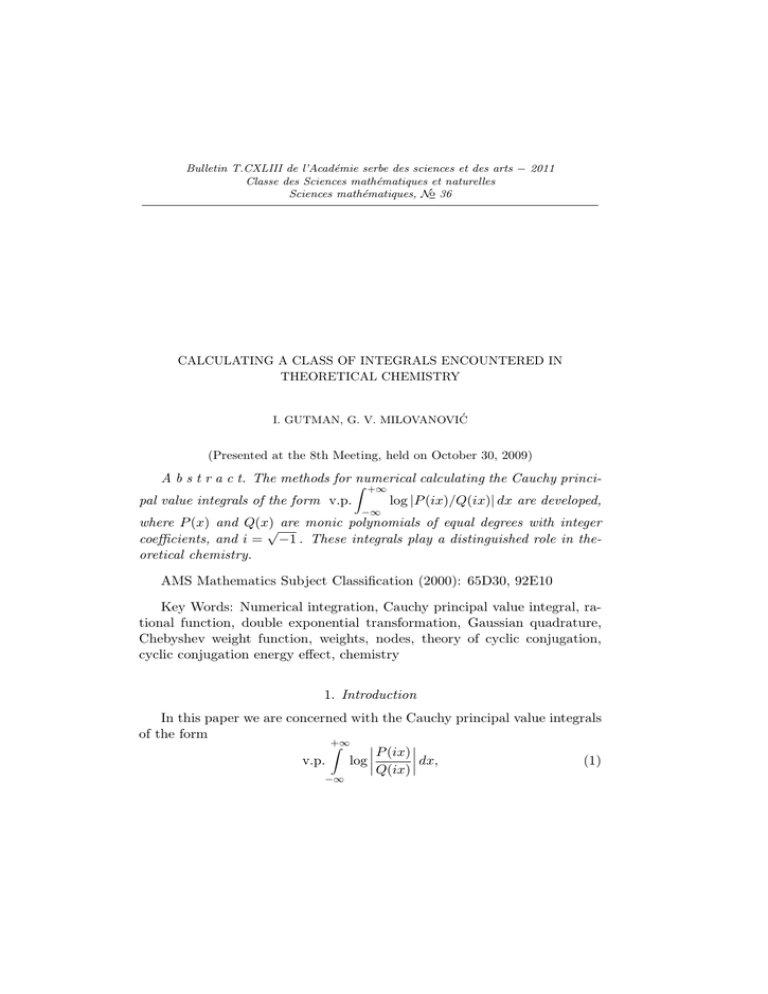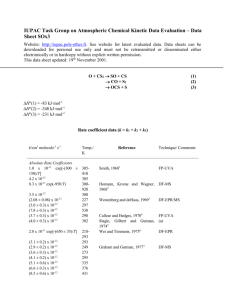− 2011 Bulletin T.CXLIII de l’Acad´ Classe des Sciences math´
advertisement

Bulletin T.CXLIII de l’Académie serbe des sciences et des arts − 2011
Classe des Sciences mathématiques et naturelles
Sciences mathématiques, No 36
CALCULATING A CLASS OF INTEGRALS ENCOUNTERED IN
THEORETICAL CHEMISTRY
I. GUTMAN, G. V. MILOVANOVIĆ
(Presented at the 8th Meeting, held on October 30, 2009)
A b s t r a c t. The methods for ∫numerical calculating the Cauchy princi+∞
pal value integrals of the form v.p.
−∞
log |P (ix)/Q(ix)| dx are developed,
where P (x) and Q(x)
√ are monic polynomials of equal degrees with integer
coefficients, and i = −1 . These integrals play a distinguished role in theoretical chemistry.
AMS Mathematics Subject Classification (2000): 65D30, 92E10
Key Words: Numerical integration, Cauchy principal value integral, rational function, double exponential transformation, Gaussian quadrature,
Chebyshev weight function, weights, nodes, theory of cyclic conjugation,
cyclic conjugation energy effect, chemistry
1. Introduction
In this paper we are concerned with the Cauchy principal value integrals
of the form
+∞
∫
P (ix) dx,
v.p.
log (1)
Q(ix) −∞
2
I. Gutman, G. V. Milovanović
where
P (x) =
n
∑
ak xk
and
Q(x) =
k=0
n
∑
b k xk
(2)
k=0
are polynomials
of equal degree whose coefficients are integers, an = bn = 1 ,
√
and i = −1 .
Integrals of this kind play a significant role in theoretical (quantum)
chemistry. It seems that such integrals were first considered by Coulson and
Jacobs [10], who showed that the difference between the total π-electron
energy of two conjugated hydrocarbons with equal number of carbon atoms
is given by
1
E(G2 ) − E(G1 ) = v.p.
π
+∞
∫
ϕ(G1 , ix) dx
ϕ(G , ix) log −∞
(3)
2
where G1 and G2 are the corresponding molecular graphs [67], and ϕ stands
for their characteristic polynomial. This formula is an immediate consequence of Coulson’s classic integral expression for the total π-electron energy
[9, 67]:
1
E(G) = v.p.
π
+∞
∫ [
]
ix ϕ′ (G, ix)
n−
dx
ϕ(G, ix)
−∞
(4)
ϕ′
where
denotes the first derivative of ϕ .
Several variants of Eq. (3), pertaining to energy differences, were considered in the chemical literature [18, 19, 28, 42]. Of these, the so-called
“topological resonance energy” should especially be mentioned [60, 60]:
1
TRE (G) = v.p.
π
ϕ(G, ix) dx
log α(G, ix) +∞
∫
−∞
(5)
where α is the matching polynomial.
It should be noted that in actual chemical applications (which are very
numerous) both the total π-electron energy and the topological resonance
energy are not computed by means of the formulas (3)–(5), but by using
other computational techniques. However, there is another chemical theory
in which calculation of numerical values of integrals of the type (1) cannot
be avoided.
In 1977 one of the present authors [7, 17, 43] developed a novel theory of
cyclic conjugation which made it possible to assess the effect of an individual
Calculating a class of integrals encountered in theoretical chemistry
3
cycle on the thermodynamic stability of a polycyclic conjugated molecule.
Details of this theory can be found in several expository articles [27, 36, 37,
38], whereas its mathematical formalism is outlined in [66, 67]. Almost in
the same time Aihara [1] proposed a similar, yet not equivalent, theory, in
which no integrals of the type (1) were used. The advantage of our approach
over Aihara’s was recognized only many years later [2]
Within our theory of cyclic conjugation, the energy-effect of a cycle Z of
a polycyclic conjugated molecule whose molecular graph is G is computed
as:
1
ef (G, Z) = v.p.
π
ϕ(G, ix)
dx.
log ϕ(G, ix) + 2 ϕ(G − Z, ix) +∞
∫
−∞
(6)
Recently, analogous expressions for the effects of pairs, triplets, quartets,
etc. of cycles were deduced [74], as well as for the effect of conjugation in
one cycle on conjugation in another cycle [91, 68, 16, 92, 39].
The quantity ef was extensively studied and applied to a variety of chemical problems. These researches were done either by finding some generally
valid mathematical properties of ef [20, 21, 22, 24, 30, 65] or by performing
numerical calculations [12, 25, 26, 29, 31, 32, 33, 34, 35, 41, 44, 45, 50, 51,
52, 53, 54, 56, 57, 61, 62, 63, 64, 69, 70, 71, 75, 72, 74, 76, 77, 78, 79, 5, 73,
81, 90, 4, 49, 48, 47, 3, 15, 55, 82, 46, 13, 14].
In the general case, the polynomials P (x) ≡ ϕ(G, x) and Q(x) ≡ ϕ(G, x)+
2 ϕ(G − Z, x) , occurring in the expression on the right–hand side of Eq. (6)
are monic, of equal degree, and have integer coefficients. The zeros of Q(x)
may be complex-valued and in practical applications are not known.
For x → ±∞ the integrand in (6) tends to zero as x−|Z| , where |Z| ≥ 3
is the size of the cycle Z . At x = 0 the integrand may possess a singularity.
In standard chemical applications of the integrals of the form (1) it is
assumed that the coefficients a1 and b1 in the polynomials P (x) and Q(x)
are equal to zero. If this is not the case, then pertinent corrections need to
be made [58, 85].
The hitherto reported ef-values were computed by means of a Simpson–
type integration [40], in which the integrand is computed for x = 21 h + kh
for k = 0, 1, 2, . . . , up to the point at which the integrand is smaller than
a critical value C. By empirical testing it was found that h = 0.004 and
C = 0.00001 yield ef-values accurate to 3 or 4 decimal places. However, this
latter accuracy could be tested only for the few (simple) examples for which
the right–hand side of (6) can be solved analytically.
4
I. Gutman, G. V. Milovanović
In the subsequent sections we show how integrals of the type (1) can be
calculated in a much more efficient and much more accurate manner. Two
methods are presented. In both cases a previous reduction to an integral
with a rational function is provided (Section 2). In Section 3 we apply
the trapezoidal rule after the so-called double exponential ransformation
of the integrand. Such ideas have been appeared in papers of Japanese
mathematicians (cf. Takahasi and Mori [93, 94], Iri, Moriguti, and Takasawa
[80], Mori [89]). The second method, presented in Section 4, is based on a
transformation of the integral over the real line to an integral over the finite
interval (−1, 1), with respect to the Chebyshev weights. An application of
the corresponding quadratures of Gaussian type is also presented.
2. Reduction to integrals of rational functions
In this section we reduce the Cauchy principal value integral (1) to an
improper integral of a rational function over R.
Let Pn be a set of all real algebraic polynomials of degree at most n and
P̂n be its subset of monic polynomials of degree n. With R[m, n] we denote
the set of all rational functions of the form u(t)/v(t) such that u ∈ Pm ,
v ∈ P̂n , and gcd(u(t), v(t)) = 1 (i.e., the polynomials u(t) and v(t) are
relatively prime).
According to (2) we have
P (ix)P (−ix) = (a0 − a2 x2 + a4 x4 − · · · )2 + x2 (a1 − a3 x2 + a5 x4 − · · · )2 ,
i.e., |P (ix)|2 = P (ix)P (−ix) = p(x2 ) and similarly |Q(ix)|2 = Q(ix)Q(−ix) =
q(x2 ). Such polynomials
p(t) = tn + αtn−1 + · · ·
q(t) = tn + βtn−1 + · · ·
and
are real monic polynomials of degree n and nonnegative for t ≥ 0. Without
loss of generality, we can suppose that they are relatively prime. In addition,
we suppose that they have not positive zeros, i.e., p(t), q(t) > 0 for t > 0.
Then
+∞
+∞
∫
∫
P (ix) P (ix) 2
p(x2 )
1
1
log log
log
dx
=
v.p.
dx
=
v.p.
dx.
Q(ix) Q(ix) 2
2
q(x2 )
+∞
∫
v.p.
−∞
−∞
−∞
An integration by parts gives
1
2
∫
p(x2 )
x
p(x2 )
log
dx
=
log
−
q(x2 )
2
q(x2 )
(
∫
x
2
)
p′ (x2 ) q ′ (x2 )
−
dx.
p(x2 )
q(x2 )
(7)
5
Calculating a class of integrals encountered in theoretical chemistry
Defining a rational function R(t) by
(
R(t) = t
q ′ (t) p′ (t)
−
q(t)
p(t)
)
=
h(t)
,
p(t)q(t)
(8)
where h(t) = t(p(t)q ′ (t) − q(t)p′ (t)), we get
{
R(t) = t
= t
ntn−1 + (n − 1)βtn−2 + · · · ntn−1 + (n − 1)αtn−2 + · · ·
−
tn + βtn−1 + · · ·
tn + αtn−1 + · · ·
}
(α − β)t2n−2 + · · ·
∈ R[2n − 1, 2n].
p(t)q(t)
Precisely, R(t) ∈ R[m, 2n] for some m between 0 and 2n − 1.
Thus, R(x2 ) = o(x−2r ) as x → +∞, where r ≥ 1. For t > 0 the
denominator of the rational function R(t) is strictly positive, except t = 0,
but this function R(t) cannot have a pole at the origin. Namely, if p(t) or
q(t) (not both) has a zero at the origin, then such a pole is eliminated by
the factor t in h(t). Regarding these facts, we have the existence of the
improper integral
+∞
∫
R(x2 ) dx.
−∞
Also, by definition of the Cauchy principal value integral, it is easy to conclude that the first term on the right hand side in (7) has no contribution
in the integral (1), so that the following result holds:
Lemma 1 For the integral (1) we have
+∞
∫
P (ix) log dx
=
R(x2 ) dx,
Q(ix) +∞
∫
v.p.
−∞
(9)
−∞
where the function R(t) ∈ R[m, 2n] (0 ≤ m ≤ 2n − 1) has the form (8),
where h ∈ Pm and p, q ∈ P̂n .
For example, for p(t) = t2 + 4t and q(t) = t2 + 4t + 2, according to (8)
and (9), we get
+∞
∫
v.p.
−∞
log
x4 + 4 x2
dx =
x4 + 4 x2 + 2
+∞
∫
−∞
−8(x2 + 2)
dx.
(x2 + 4)(x4 + 4x2 + 2)
6
I. Gutman, G. V. Milovanović
Thus, it is reduced to an improper integral, which value is
−2π
(√
4+2
√
)
2 − 2 = −3.852383833273321 . . . .
Thus, our starting problem (1) is reduced to an integration of rational
functions over R. It is well known that in the eighteenth century Johan
Bernoulli solved the problem of indefinite integration of rational functions
by their partial decomposition. The main computational problem with this
method is computing the factorization of a polynomial. However, in the
middle of the nineteenth century the Russian mathematician Mikhail Vasilyevich Ostrogradsky presented an algorithm for finding the rational part of
the integral without factoring. Some similar approaches were latter discovered. The problem of computing the transcendental part of the primitive
was recently solved. The recent development of symbolic computations made
also a progress in this area (for details see a book of Bronstein [8], as well
as some papers dealing with Landen transformation for rational functions
[6] and [83]).
For our specific kind of integrals in the subsequent sections we give two
efficient methods for their numerical calculating.
3. Double exponential transformation and trapezoidal rule
We start
this section with some classical rules for calculating the integral
∫b
I(f ) := a f (x) dx.
Taking h := (b − a)/n and equally spaced points xk := a + kh, k =
0, 1, . . . , n, we have the well-known composite trapezoidal rule
(
)
1
1
f0 + f1 + · · · + fn−1 + fn ,
I(f ) ≈ Tn (f ; h) := h
2
2
(10)
where fk := f (xk ), k = 0, 1, . . . , n. If f ∈ C 2 [a, b] it is easy to prove that
I(f ) − Tn (f ; h) = −
(b − a)h2 ′′
f (ξ),
12
a < ξ < b.
(11)
As we can see this rule converges very slowly with respect to step refinement
as O(h2 ).
Another simple rule is the classical composite Simpson rule
I(f ) ≈ Sn (f ; h) :=
]
h[
f0 + 4(f1 + · · · + f2n−1 ) + 2(f2 + · · · + f2n−2 ) + f2n ,
3
7
Calculating a class of integrals encountered in theoretical chemistry
where h := (b − a)/2n, xk := a + kh, fk := f (xk ), k = 0, 1, . . . , 2n, which
is slightly faster, but complicated than the previous one. Namely, if f ∈
C 4 [a, b],
I(f ) − Sn (f ; h) = −
(b − a)h4 (4)
f (ξ),
180
a < ξ < b.
For functions with continuous derivatives of order at least 2m − 1, a
generalization of (11) is the well-known Euler-Maclaurin summation formula
I(f ) − Tn (f ; h) = −
h2 ′
h4 ′′′
(f (b) − f ′ (a)) +
(f (b) − f ′′′ (a))
12
720
− ··· −
)
h2m B2m ( (2m−1)
f
(b) − f (2m−1) (a) − Em (f ),
(2m)!
where B2m is the Bernoulli number of order 2m and
Em (f ) = (b − a)
B2m+2 h2m+2 (2m+2)
f
(ξ),
(2m + 2)!
a < ξ < b.
If we restrict our analysis to analytic functions with all derivatives of f which
vanish at x = a and x = b, then the discretization error is given only by
remainder Em (f ) as m → +∞. Then the convergence with respect to step
refinement is faster than any finite order and the trapezoidal rule becomes a
method of choice. Such a convergence is known as exponential convergence.
In order to calculate the integral (9) with the trapezoidal rule with the
previous property we first apply the so-called double-exponential transformation x = u(t) = sinh((π/2) sinh t), reducing it to
+∞
∫
+∞
∫
I=
R(x ) dx =
−∞
i.e.,
π
I=
2
+∞
∫
(
R sinh2
−∞
R(u(t)2 )u′ (t) dt,
2
−∞
(
π
sinh t
2
))
(
cosh
)
π
sinh t cosh t dt.
2
(12)
The crucial point in this transformation is the decay of the integrand be
double exponential, i.e.,
|R(u(t)2 )u′ (t)| ≈ exp(−C exp |t|)
as |t| → +∞,
8
I. Gutman, G. V. Milovanović
where C is some positive constant. For an integral of such form of an analytic
function on (−∞, +∞), it is known that the trapezoidal formula with an
equal mesh size gives an optimal formula (cf. [80, 87, 88, 89, 93, 94, 95]).
In our case we apply the trapezoidal formula with an equal mesh size h,
so that we obtain
(
Ih =
(
∑
πh +∞
π
R sinh2
sinh kh
2 k=−∞
2
))
(
cosh
)
π
sinh kh cosh kh.
2
Since the integrand decays double exponentially, in actual computation of
the previous sum we truncate the infinite summation at k = −M and k = M ,
so that we obtain the double-exponential (DE) formula for our integral
(N )
I ≈ Ih
(
=
(
))
M
π
πh ∑
R sinh2
sinh kh
2 k=−M
2
(
cosh
)
π
sinh kh cosh kh,
2
where N = 2M + 1.
Example 1 Let ϕ(G, x) = x10 − 11x8 + 41x6 − 65x4 + 43x2 − 9 and
ϕ(G − Z, x) = x4 − 3x2 + 1. Then we have P (x) = ϕ(G, x) and Q(x) =
ϕ(G, x) + 2ϕ(G − Z, x), so that
|P (ix)|2 = P (ix)P (−ix) = (9 + 43x2 + 65x4 + 41x6 + 11x8 + x10 )2 ,
|Q(ix)|2 = Q(ix)Q(−ix) = (7 + 37x2 + 63x4 + 41x6 + 11x8 + x10 )2 ,
i.e.,
)
(
2 + 8x4 + x6 2
P (ix) 2
9
+
16x
,
Q(ix) = 7 + 16x2 + 8x4 + x6
because of gcd(|P (ix)|2 , |Q(ix)|2 ) = (1 + 3x2 + x4 )2 . The problem can be
additionally simplified by taking (see Lemma 1): p(t) = 9 + 16t + 8t2 + t3 ,
q(t) = 7 + 16t + 8t2 + t3 , h(t) = 2t(p(t)q ′ (t) − q(t)p′ (t)) = 2t(16 + 16t + 3t2 ),
and
R(t) = 2
4t(16 + 16t + 3t2 )
h(t)
=
.
p(t)q(t)
(7 + 16t + 8t2 + t3 )(9 + 16t + 8t2 + t3 )
Thus, R(t) ∈ R[3, 6]. The behavior of the function R(x2 ) is presented
in Fig. 1. Its values for x = ±5, ±10, ±15, ±20 are 0.000518, 0.0000108,
1.005 × 10−6 , 1.826 × 10−7 , respectively.
9
Calculating a class of integrals encountered in theoretical chemistry
0.15
0.10
0.05
0.00
-4
-2
0
2
4
Fig. 1. The function R(x2 )
0.30
0.25
0.20
0.15
0.10
0.05
0.00
-2
-1
0
1
2
Fig. 2. The function R(u(t)2 )u′ (t)
However, after DE transformation x = u(t) = sinh((π/2) sinh t), the integrand R(u(t)2 )u′ (t) decays double exponentially (see Fig. 2). For example,
its values for t = ±1, ±2, ±3 ± 4 are 0.04298, 9.654 × 10−10 , 4.102 × 10−31 ,
1.357 × 10−89 , respectively.
Taking the bounds in the integral as a = −3 and b = 3 (corresp. value of
integrand 4.102 × 10−31 ), for N = 10(10)100 we get the trapezoidal approx(N +1)
imations Ih
. Table 1 shows these approximations, together with the
relative errors. In each entry of the second column the first digit in error
is underlined. In the third column numbers in parentheses indicate decimal
exponents, for example 1.40(−2) = 1.40 × 10−2 .
The exact value (to 33 significant digits), as determined by the method
in the next section, is 0.380477864729266685437345222424304. The corresponding exact value of (6) is ef (G, Z) = 0.121109865817424581769007 . . . .
10
I. Gutman, G. V. Milovanović
(N +1)
Table 1. Numerical approximations Ih
and
the corresponding relative errors for N = 10(10)100
N
10
20
30
40
50
60
70
80
90
100
(N +1)
Ih
0.385796
0.38049435
0.38047789486
0.38047786477677
0.3804778647293509
0.3804778647292668368
0.3804778647292666856998
0.3804778647292666854378032
0.380477864729266685437346027
0.3804778647292666854373452238
erel
1.40(−2)
4.33(−5)
7.92(−8)
1.25(−10)
2.21(−13)
3.98(−16)
6.90(−19)
1.20(−21)
2.11(−24)
3.70(−27)
4. Transformation to the finite interval and Gaussian formulae
√
In this section we propose another transformation x = −t/ 1 − t2 (cf.
[88]) in order to reduce (9) to the following integral over the finite interval
(−1, 1),
+∞
∫
R(x ) dx =
−∞
(
∫1
2
R
−1
t2
1 − t2
)
dt
,
(1 − t2 )3/2
(13)
where R(t) is defined in (8). This suggests us to apply some of Gaussian
formulas for numerical calculation of (13). Namely, the Gaussian quadrature
rule with respect to the Gegenbauer weight wλ (t) = (1−t2 )λ−1/2 , λ > −1/2,
∫1
φ(t) wλ (t) dt =
−1
N
∑
Aλk φ(τkλ ) + RN (φ),
(14)
k=1
could be appropriate for this purpose. The nodes τkλ , k = 1, . . . , N , are
λ (t) of degree N , and the weights Aλ ,
zeros of the Gegenbauer polynomial CN
k
k = 1, . . . , N , are the corresponding Christoffel numbers (cf. [84, Chap. 5]).
They can be calculated in an efficient way by using the Mathematica
Package “OrthogonalPolynomials” [11].
Example 2 Consider again the integral from Example 1. In this case,
the integral (13), written as a weighted integral with respect to the Gegen-
11
Calculating a class of integrals encountered in theoretical chemistry
bauer weight wλ (t), becomes
∫1
−1
(
)(
)2−λ
4t2 3t4 − 16t2 + 16 1 − t2
wλ (t) dt.
(3t4 − 11t2 + 9) (2t6 − 3t4 − 5t2 + 7)
The complete integrand R(t2 /(1 − t2 ))(1 − t2 )−3/2 is presented in Fig. ??.
Applying the corresponding Gaussian formula (14) for λ = 0, 1/2, 1, 3/2, 2
to the previous integral we obtain results with the relative errors presented
in Table 2. Note that this parameter λ must be such that −1/2 < λ ≤ 2.
0.4
0.3
0.2
0.1
0.0
-1.0
-0.5
0.0
0.5
1.0
Fig. 3. The function R(t2 /(1 − t2 ))(1 − t2 )−3/2 in Example 2
Table 2. Relative errors in Gauss-Gegenbauer quadrature sums
for some selected values of λ
N
10
20
30
40
50
60
70
80
90
100
λ=0
9.99(−4)
1.64(−7)
2.06(−11)
2.33(−15)
2.48(−19)
2.54(−23)
2.54(−27)
2.49(−31)
2.41(−35)
2.31(−39)
λ = 1/2
1.18(−3)
2.77(−5)
3.39(−6)
7.95(−7)
2.60(−7)
1.04(−7)
4.84(−8)
2.48(−8)
1.38(−8)
8.16(−9)
λ=1
4.28(−4)
6.72(−8)
8.34(−12)
9.35(−16)
9.91(−20)
1.01(−23)
1.01(−27)
9.89(−32)
9.56(−36)
9.14(−40)
λ = 3/2
1.24(−3)
3.75(−5)
5.16(−6)
1.27(−6)
4.27(−7)
1.75(−7)
8.19(−8)
4.25(−8)
2.38(−8)
1.41(−8)
λ=2
2.75(−4)
3.42(−8)
3.90(−12)
4.20(−16)
4.33(−20)
4.35(−24)
4.28(−28)
4.16(−32)
3.99(−36)
3.79(−40)
As we can see, the convergence is slow only √
if the integrand has an
irrational factor. In these cases it is the factor “ 1 − t2 ” which appears
for λ = 1/2 (Gauss-Legendre quadrature) and λ = 3/2. In other cases this
12
I. Gutman, G. V. Milovanović
factor is included in the weight function and the corresponding function
φ(t) is a pure rational function. Regarding this fact we prefer to use GaussChebyshev quadrature formulas (for λ = 0 and λ = 1), because of their
simplicity.
In a general case, the rational function R(t) belongs to R[m, 2n], where
0 ≤ m ≤ 2n − 1 (see Lemma 1), and therefore it has the following form
m
∑
R(t) =
k=0
2n
∑
r k tk
.
sk tk
k=0
Regarding (13), we have
+∞
∫
∫1
2
R(x ) dx =
−∞
−1
m
∑
k=0
2n
∑
rk t2k (1 − t2 )m−k
(1 − t2 )ℓ · √
sk t2k (1 − t2 )2n−k
dt
,
1 − t2
k=0
where ℓ = 2n − m − 1 ≥ 0. Thus, the Gauss-Chebyshev quadrature of the
first kind (λ = 0) can be always applied to the integral (13). However, the
corresponding Gauss-Chebyshev quadrature of the second kind (λ = 1) can
be applied if m ≤ 2n − 2.
Now, we derive explicit expressions for these Gaussian quadrature sums
+∞
∫
λ
R(x2 ) dx ≈ SN
(R)
(λ = 0, 1).
(15)
−∞
Number of functional evaluations in these sums is reduced to N/2.
Theorem 1 Let N ∈ N, R(t) ∈ R[m, 2n], 0 ≤ m ≤ 2n − 1, and ξk =
(2k − 1)π
, k = 1, . . . , [N/2]. Then
2N
cot2
0
SN
(R) =
[N/2]
2π ∑
π
(1 + ξk )R(ξk ) + εN R(0),
N k=1
N
where εN = 0 if N is even, and εN = 1 if N is odd.
(16)
13
Calculating a class of integrals encountered in theoretical chemistry
Proof: Let λ = 0 and φ(t) be defined as
1
φ(t) =
R
1 − t2
(
t2
1 − t2
)
.
Then for the N -point Gauss-Chebyshev quadrature sum of the first kind in
(2k − 1)π
(14), with the nodes τk = τk0 = cos θk , where θk =
, k = 1, . . . , N ,
2N
all weight coefficients are equal, i.e., Ak = A0k = π/N (cf. [86, p. 174]).
Therefore,
0
SN
(R)
N
π ∑
1
=
R
N k=1 1 − cos2 θk
(
cos2 θk
1 − cos2 θk
)
=
N
π ∑
1
R(cot2 θk ),
N k=1 sin2 θk
i.e.,
0
SN
(R) =
which reduces to (16).
N
π ∑
(1 + cot2 θk ) R(cot2 θk ),
N k=1
2
Theorem 2 Let N ∈ N, R(t) ∈ R[m, 2n], 0 ≤ m ≤ 2n − 2, and ηk =
kπ
N + 1 , k = 1, . . . , [N/2]. Then
cot2
1
SN
(R)
[N/2]
2π ∑
π
=
(1 + ηk )R(ηk ) + εN
R(0),
N + 1 k=1
N +1
(17)
where εN = 0 if N is even, and εN = 1 if N is odd.
Proof: In this case λ = 1 and
1
φ(t) =
R
(1 − t2 )2
(
t2
1 − t2
)
.
Nodes of the corresponding N -point quadrature are zeros of the
√ Chebyshev
polynomial of the second kind UN (t) = sin[(N + 1) arccos t]/ 1 − t2 , i.e.,
τk = τk1 = cos θk , where θk = Nkπ
+ 1 , k = 1, . . . , N , and the weight coefficients are Ak = A1k = N π+ 1 sin2 θk , k = 1, . . . , N (cf. [86, p. 174]).
Therefore,
1
SN
(R)
N
π ∑
sin2 θk
=
R
N + 1 k=1 (1 − cos2 θk )2
(
cos2 θk
1 − cos2 θk
)
14
I. Gutman, G. V. Milovanović
reduces to (17). 2
The obtained formulas (16) and (17) are very simple for implementing
and using in integration. For example, the function R(t) from Examples 1
and 2 belongs to R[3, 6] and Theorem 2 can be applied. The quadrature
1 (R) for N = 10(10)100 are presented in Table ??.
sums SN
1
(R) for N = 10(10)100
Table 3. Quadrature sums SN
N
10
20
30
40
50
60
70
80
90
100
1
Quadrature sum SN
(R)
0.3806407
0.38047789027
0.38047786473243
0.380477864729267041
0.38047786472926668547505
0.380477864729266685437349077
0.3804778647292666854373452228086
0.38047786472926668543734522242434194
0.380477864729266685437345222424304306513
0.3804778647292666854373452224243043028756715
REFERENCES
[1] J. Aihara, Resonance energies of benzenoid hydrocarbons, J. Am. Chem. Soc. 99
(1977) 2048–2053.
[2] J. Aihara, Circuit resonance energy: A key quantity that links energetic and magnetic
criteria of aromaticity, J. Am. Chem. Soc. 128 (2006) 2873–2879.
- urd-ević, I. Gutman, Comments on π-electron conjugation in
[3] A. T. Balaban, J. D
the five-membered ring of benzo-derivatives of corannulene, Polyc. Arom. Comp. 29
(2009) 185–205.
- urd-ević, I. Gutman, S. Jeremić, S. Radenković, Correlations
[4] A. T. Balaban, J. D
between local aromaticity indices of bipartite conjugated hydrocarbons, J. Phys. Chem.
A 114 (2010) 5870–5877.
- urd-ević, Effect of benzo–annelation on
[5] A. T. Balaban, I. Gutman, S. Jeremić, J. D
cyclic conjugation, Monatsh. Chem. 142 (2011) 53–57.
[6] G. Boros, V. H. Moll, Landen transformations and the integration of rational functions, Math. Comp. 71 (2002), 649–668.
[7] S. Bosanac, I. Gutman, Effect of a ring on the stability of polycyclic conjugated
molecules, Z. Naturforsch. 32a (1977) 10–12.
[8] M. Bronstein, Symbolic Integration I. Transcendental functions, Second Edition, Algorithms and Computation in Mathematics, Vol. 1, Springer-Verlag, Berlin – Heidelberg, 2005.
[9] C. A. Coulson, On the calculation of the energy in unsaturated hydrocarbon molecules,
Proc. Cambridge Phil. Soc. 36 (1940) 201–203.
Calculating a class of integrals encountered in theoretical chemistry
15
[10] C. A. Coulson, J. Jacobs, Conjugation across a single bond , J. Chem. Soc. (1949)
2805–2812.
[11] A. S. Cvetković, G. V. Milovanović, The Mathematica Package “OrthogonalPolynomials”, Facta Univ. Ser. Math. Inform. 19 (2004), 17–36.
- urd-ević, B. Furtula, I. Gutman, R. Kovačević, S. Stanković, N. Turković, Cyclic
[12] J. D
conjugation in annelated perylenes, in: I. Gutman (Ed.), Mathematical Methods in
Chemistry, Prijepolje Museum, Prijepolje, 2006, pp. 101–117.
- urd-ević, B. Furtula, I. Gutman, S. Radenković, S. Stanković, Comparative study
[13] J. D
of cyclic conjugation in tribenzoperylene isomers, in: A. Graovac, I. Gutman, D.
Vukičević (Eds.), Mathematical Methods and Modelling for Students of Chemistry
and Biology, Hum, Zagreb, 2009, pp. 29–39.
- urd-ević, I. Gutman, J. Terzić, A. T. Balaban, Cyclic conjugation in fluoranthene
[14] J. D
and its benzo–derivatives. Part 1. Catacondensed systems, Polyc. Arom. Comp. 29
(2009) 90–102.
- urd-ević, S. Radenković, I. Gutman, S. Marković, Testing the PCP–rule, Monatsh.
[15] J. D
Chem. 140 (2009) 1305–1309.
[16] B. Furtula, I. Gutman, S. Jeremić, S. Radenković, Effect of a ring on cyclic conjugation in another ring: Applications to acenaphthylene–type polycyclic conjugated
molecules, J. Serb. Chem. Soc. 75 (2010) 83–90.
[17] I. Gutman, Proof of the Hückel rule, Chem. Phys. Lett. 46 (1977) 169–171.
[18] I. Gutman, Electronic properties of Möbius systems Z. Naturforsch. 33a (1978) 214–
216.
[19] I. Gutman, Topological studies on heteroconjugated molecules. Alternant systems with
one heteroatom, Theor. Chim. Acta 50 (1979) 287–297.
[20] I. Gutman, Effect of cycles on total π-electron energy of alternant conjugated hydrocarbons, J. Chem. Soc. Faraday Trans. II 75 (1979) 799–805.
[21] I. Gutman, Two theorems on topological resonance energy, J. Serb. Chem. Soc. 44
(1979) 173–178.
[22] I. Gutman, Effect of cycles on topological resonance energy, Croat. Chem. Acta 53
(1980) 581–586.
[23] I. Gutman, On cyclic conjugation, Theor. Chim. Acta 66 (1984) 43–49.
[24] I. Gutman, Overlooked relations in the theory of cyclic conjugation, Chem. Phys.
Lett. 117 (1985) 614–616.
[25] I. Gutman, Cyclic conjugation in porphin, Croat. Chem. Acta 58 (1985) 359–369.
[26] I. Gutman, Cyclic conjugation in fully benzenoid hydrocarbons, Rep. Mol. Theory 1
(1990) 115–119.
[27] I. Gutman, Dependence of physico–chemical properties of substances on molecular
structure: The example of total π-electron energy, Glas Acad. Serbe Sci. Arts 362
(1990) 83–91 (in Serbian).
[28] I. Gutman, Topological studies on heteroconjugated molecules. VI. Alternant systems
with two heteroatoms, Z. Naturforsch. 45a (1990) 1085–1089.
16
I. Gutman, G. V. Milovanović
[29] I. Gutman, Violations of the Hückel (4n + 2) rule, J. Chin. Chem. Soc. 40 (1993)
7–10.
[30] I. Gutman, Hückel rule in catacondensed benzenoid hydrocarbons, MATCH Commun.
Math. Comput. Chem. 29 (1993) 51–60.
[31] I. Gutman, Cyclic conjugation in benzenoid hydrocarbons, Bull. Acad. Serbe Sci. Arts
106 (1993) 37–50.
[32] I. Gutman, Cyclic conjugation in phenylenes, S. Afr. J. Chem. 47 (1994) 53–55.
[33] I. Gutman, Cyclic conjugation in antikekulene and its homologues, Rev. Roum. Chim.
39 (1994) 943–947.
[34] I. Gutman, Cyclic conjugation in dianions: effect of cycles on the thermodynamic
stability of polycyclic conjugated dianions, J. Mol. Struct. (Theochem) 428 (1998)
241–246.
[35] I. Gutman, On the oxidation of dibenzo[ fg,ij]pentaphene and, dinaphtho[2,1,8,7–
defg:2’,1’,8’,7’-ijkl]pentaphene dianions, J. Serb. Chem. Soc. 64 (1999) 563–570.
[36] I. Gutman, Cyclic conjugation energy effects in polycyclic π-electron systems,
Monatsh. Chem. 136 (2005) 1055–1069.
[37] I. Gutman, What chemists could not see without mathematics – Dependence of total
π-electron energy on molecular structure, Kragujevac J. Sci. 27 (2005) 57–66.
[38] I. Gutman, What chemists could not see without mathematics – Dependence of total
π-electron energy on molecular structure, Xjenza (Malta) 10 (2005) 3–7.
[39] I. Gutman, Theory of the PCP effect and related phenomena, J. Math. Chem. 47
(2010) 1309–1312.
[40] I. Gutman, On a class of integrals encountered in theoretical chemistry, Int. J. Chem.
Model. 2 (2010) 335–341.
[41] I. Gutman, P. U. Biedermann, V. Ivanov–Petrović, I. Agranat, Cyclic conjugation
effects in cyclacenes, Polyc. Arom. Comp. 8 (1996) 189–202.
[42] I. Gutman, S. Bosanac, Topological studies on heteroconjugated molecules. The stability of alternant systems with one heteroatom, Chem. Phys. Lett. 43 (1976) 371–373.
[43] I. Gutman, S. Bosanac, Quantitative approach to Hückel rule. The relations between
the cycles of a molecular graph and the thermodynamic stability of a conjugated
molecule, Tetrahedron 33 (1977) 1809–1812.
[44] I. Gutman, S. Bosanac, Quantitative testing of the perimeter rule, J. Serb. Chem.
Soc. 42 (1977) 499–502.
[45] I. Gutman, S. J. Cyvin, V. Petrović, A. Teodorović, Fully-naphthalenoid hydrocarbons
and their conjugation modes, Polyc. Arom. Comp. 4 (1994) 183–189.
- urd-ević, On π-electron conjugation in the five-membered ring of
[46] I. Gutman, J. D
fluoranthene-type benzenoid hydrocarbons, J. Serb. Chem. Soc. 74 (2009) 765–771.
- urd-ević, A. T. Balaban, A regularity for cyclic conjugation in ace[47] I. Gutman, J. D
naphthylene, fluoranthene and their congeners, Polyc. Arom. Comp. 29 (2009) 3–11.
- urd-ević, B. Furtula, B. Milivojević, Cyclic conjugation in mono–
[48] I. Gutman, J. D
and dicyclopenta–derivatives of anthracene and phenanthrene, Indian J. Chem. 47A
(2008) 803–807.
Calculating a class of integrals encountered in theoretical chemistry
17
[49] I. Gutman, B. Furtula, Cyclic conjugation in pyracylene, Polyc. Arom. Comp. 28
(2008) 136–142.
- urd-ević, R. Kovačević, S. Stanković, Annelated perylenes:
[50] I. Gutman, B. Furtula, J. D
Benzenoid molecules violating the Kekulé–structure–based cyclic conjugation models,
J. Serb. Chem. Soc. 70 (2005) 1023–1031.
[51] I. Gutman, V. Ivanov–Petrović, Unusual modes of cyclic conjugation in phenylenes,
Bull. Chem. Technol. Maced. 16 (1997) 91–96.
[52] I. Gutman, V. Ivanov–Petrović, Clar theory and phenylenes, J. Mol. Struct.
(Theochem) 389 (1997) 227–232.
[53] I. Gutman, V. Ivanov–Petrović, J. R. Dias, Cyclic conjugation in total resonant sextet
benzenoid hydrocarbons, Polyc. Arom. Comp. 18 (2000) 221–229.
[54] I. Gutman, V. Ivanov–Petrović, S. Pogodin, Unusual conjugation pattern in a class
of benzenoid hydrocarbons, Indian J. Chem. 35A (1996) 87–92.
[55] I. Gutman, S. Jeremić, V. Petrović, Extending the PCP rule, Indian J. Chem. 48A
(2009) 658–662.
[56] I. Gutman, S. L. Lee, Cyclic conjugation in circulenes, Bull. Inst. Chem. Acad. Sin.
40 (1993) 47–54.
[57] I. Gutman, Z. Marković, I. Juranić, A Clar–type regularity for dianions of benzenoid
hydrocarbons, Polyc. Arom. Comp. 13 (1999) 33–40.
[58] I. Gutman, M. Mateljević, Note on the Coulson integral formula, J. Math. Chem. 39
(2006) 259–266.
[59] I. Gutman, M. Milun, N. Trinajstić, Topological definition of delocalisation energy,
MATCH Commun. Math. Comput. Chem. 1 (1975) 171–175.
[60] I. Gutman, M. Milun, N. Trinajstić, Graph theory and molecular orbitals. 19. Nonparametric resonance energies of arbitrary conjugated systems, J. Am. Chem. Soc.
99 (1977) 1692–1704.
[61] I. Gutman, V. Petrović, Cyclic conjugation in benzo–annelated polyacenes, Indian J.
Chem. 31A (1992) 647–650.
[62] I. Gutman, V. Petrović, Cyclic conjugation in linear polyacenes, J. Serb. Chem. Soc.
57 (1992) 495–501.
[63] I. Gutman, V. Petrović, Cyclic conjugation in zig-zag fibonacenes, Rev. Roum. Chim.
38 (1993) 439–445.
[64] I. Gutman, V. Petrović, Theoretical study of cyclic conjugation in phenes: Some
hitherto unnoticed features, Monatsh. Chem. 126 (1995) 1179–1185.
[65] I. Gutman, V. Petrović, B. Mohar, Cyclic conjugation effects: individual, collective
and overall , Chem. Phys. Lett. 203 (1993) 378–382.
[66] I. Gutman, O. E. Polansky, Cyclic conjugation and the Hückel molecular orbital
model , Theor. Chim. Acta 60 (1981) 203–226.
[67] I. Gutman, O. E. Polansky, Mathematical Concepts in Organic Chemistry, Springer–
Verlag, Berlin, 1986.
[68] I. Gutman, S. Radenković, W. Linert, Pairwise energy effect of cyclic conjugation in
benzo–annelated perylenes, Monatsh. Chem. 141 (2010) 401–407.
18
I. Gutman, G. V. Milovanović
[69] I. Gutman, M. Stanković, Violation of the Hückel rule in alternant nonbenzenoid
hydrocarbons, J. Serb. Chem. Soc. 58 (1993) 897–903.
[70] I. Gutman, M. Stanković, Cyclic conjugation in non-Kekulean benzenoid molecules,
Coll. Sci. Pap. Fac. Sci. Kragujevac 15 (1994) 97–104.
[71] I. Gutman, M. Stanković, On the Hückel (4m + 2) rule in polycyclic alternant hydrocarbons, J. Mol. Struct. (Theochem) 309 (1994) 301–304.
[72] I. Gutman, S. Stanković, Testing the Y–rule in Clar theory, Polyc. Arom. Comp. 27
(2007) 425–436.
[73] I. Gutman, S. Stanković, Why is phenanthrene more stable than anthracene? , Maced.
J. Chem. Chem. Engin. 26 (2007) 111–114.
- urd-ević, B. Furtula, On the cycle–dependence of topo[74] I. Gutman, S. Stanković, J. D
logical resonance energy, J. Chem. Inf. Model. 47 (2007) 776–781.
[75] I. Gutman, S. Stanković, Complete analysis of cyclic conjugation energy effects: Comparison of, benzo[a]pyrene and benzo[b]pyrene, Bull. Acad. Serbe Sci. Arts 135 (2008)
29–36.
- urd-ević, B. Furtula, Anomalous cyclic
[76] I. Gutman, S. Stanković, R. Kovačević, J. D
conjugation in benzenoid molecules with a small number of Kekulé structures, Indian
J. Chem. 44A (2005) 1751–1755.
[77] I. Gutman, Ž. Tomović, On cyclic conjugation of the members of the pyrene/peropyrene series and their formally π-localized derivatives, Bull. Chem. Technol. Maced.
20 (2001) 33–37.
[78] I. Gutman, Ž. Tomović, Cyclic conjugation in terminally bent and branched
phenylenes, Indian J. Chem. 40A (2001) 678–681.
[79] I. Gutman, N. Turković, J. Jovičić, Cyclic conjugation in benzo-annelated perylenes:
How empty is the “empty” ring ? , Monatsh. Chem. 135 (2004) 1389–1394.
[80] M. Iri, S. Moriguti, Y. Takasawa, On certain quadrature formula, J. Comput. Appl.
Math. 17 (1987), 3–20.
[81] S. Jeremić, S. Radenković, I. Gutman, Cyclic conjugation in benzo-annelated
coronenes, Maced. J. Chem. Chem. Engin. 29 (2010) 63–69.
[82] S. Jeremić, S. Radenković, I. Gutman, Cyclic conjugation in benzo-annelated triphenylenes, J. Serb. Chem. Soc. 75 (2010) 943–950.
[83] D. Manna, V. H. Moll, Rational Landen transformations on R, Math. Comp. 76
(2007), 2023–2043.
[84] G. Mastraianni, G. V. Milovanović, Interpolation Processes – Basic Theory and Applications, Springer Monographs in Mathematics, Springer Verlag, Berlin – Heidelberg
– New York, 2008.
[85] M. Mateljević, I. Gutman, Note on the Coulson and Coulson–Jacobs integral formulas, MATCH Commun. Math. Comput. Chem. 59 (2008) 257–268.
[86] G. V. Milovanović, Numerical Analysis, Part II , Naučna knjiga, Beograd, 1988 (Serbian).
[87] G. V. Milovanović, Expansions of the Kurepa function, Publ. Inst. Math. (Beograd)
(N.S.) 57 (71) (1995), 81–90.
Calculating a class of integrals encountered in theoretical chemistry
19
[88] G. Monegato, L. Scuderi, Quadrature rules for unbounded intervals and their application to integral equations, In: Approximation and Computation: In Honor
of Gradimir V. Milovanović (W. Gautschi, G. Mastroianni, Th.M. Rassias, eds.),
Springer Optimization and its Applications, Vol. 42, Springer, New York, 2011, pp.
185–208.
[89] M. Mori, Quadrature formulas obtained by variable transformation and DE-rule, J.
Comput. Appl. Math. 12&13 (1985), 119–130.
[90] R. Ponec, S. Fias, S. Van Damme, P. Bultinck, I. Gutman, S. Stanković, The close
relation between cyclic delocalization, energy effects of cycles and aromaticity, Coll.
Czech. Chem. Commun. 74 (2009) 147–166.
- urd-ević, I. Gutman, Quantitative study of the PCP effect, Chem.
[91] S. Radenković, J. D
Phys. Lett. 475 (2009) 289–292.
[92] S. Radenković, W. Linert, I. Gutman, S. Jeremić, Pairwise energy effects of rings in
benzo-annelated perylenes, Indian J. Chem. 48A (2009) 1657–1661.
[93] H. Takahasi, M. Mori, Error estimation in the numerical integration of analytic functions, Report Computer Centre University of Tokyo 3 (1970), 41–108.
[94] H. Takahasi, M. Mori, Quadrature formulas obtained by variable transformation, Numer. Math. 21 (1973), 206–219.
[95] J. Waldvogel, Towards a general error theory of the trapezoidal rule, In: Approximation and Computation: In Honor of Gradimir V. Milovanović (W. Gautschi, G.
Mastroianni, Th.M. Rassias, eds.), Springer Optimization and its Applications, Vol.
42, Springer, New York, 2011, pp. 267–282.
Faculty of Science
University of Kragujevac
P. O. Box 60
34000 Kragujevac
Serbia
gutman@kg.ac.rs
Megatrend University
Faculty of Computer Sciences
Bulevar umetnosti 29
11070 Novi Beograd
Serbia
gvm@megatrend.edu.rs






